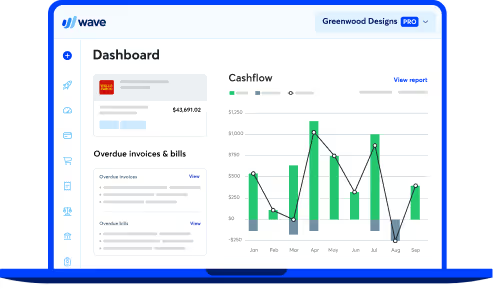
The ultimate guide to small business networking
As a small business owner, it’s important to always maintain a steady stream of new leads, new connections, and new opportunities, no matter what industry you’re in. Buuuut opportunities don’t come knocking on your door (unless they’re Girl Scout Cookies)—you have to go out and make them yourself (hey, this also totally applies to cookies during Girl Scout off season).
One way to find new opportunities is through networking. We know, we know—just the word “networking” fills a lot of business owners with dread. The terror of walking into a room full of strangers! The awkward small talk! The I-don’t-know-what-to-do-with-my-hands feeling!
Okay, okay, deep breaths. While networking can be challenging, it’s a great method to generate new business, meet like-minded people, and truly grow and improve your business. That’s why we’re here to help you feel confident about small business networking and walk into your next networking event feelin’ like the boss you are. With the right tips and game plan, networking can actually be something you look forward to!
In our all-encompassing guide to small business networking, we’ll go over an explanation of what small business networking is and why it’s important, how to network as a small business owner, and small business networking tips. Let’s get into it!
What is small business networking (and why is it important)?
Small business networking is the process of interacting with other small business owners, organizations, or stakeholders to share ideas and information and, ultimately, build professional relationships.
Networking can help you form connections and relationships with like-minded business owners, increase sales, and grow professionally and personally.
Benefits of professional networking
There’s a ton of value in networking, and it all comes down to what your goals are. Here are some of the benefits you can gain through networking that might resonate with you:
- Find a mentor. You might make a connection with someone you aspire to be like who can share best practices, budding industry trends, or common mistakes to avoid.
- Build brand awareness. The more networking events you attend, the more people will know (and talk about!) you and your business. This will help build up your reputation as a thought leader and industry expert, leading to more people thinking of you when they’re in need of a product or service you offer.
- Learn new things. By conversing with other business owners, you might hear about something new to incorporate into your business, be it a tool, process, skill, or insider info. You can share ideas and advice, gather feedback, and learn new tips and tricks from other pros.
- Find staff. Did you know nearly 85% of jobs are filled through networking? Networking can connect you with some awesome future employees.
- Meet like-minded people. Being your own boss can get lonely, don’t underestimate the value of meeting like-minded, inspirational people!
- Embrace word-of-mouth marketing. Collaborating with other businesses can amplify your reach and give you access to a new audience. Word-of-mouth recommendations impact 20–50% of all purchase decisions, and 83% of consumers trust recommendations from friends and family.
- Grow your business. Connecting with even just one new person also connects you to their network. “People like to do business with people they know,” says Lindsay Anvik, business coach and keynote speaker on leadership and marketing. In other words, your connections may refer you to their connections!
- Feel confident. Putting yourself out there and talking to new people isn’t easy! Even if you’re a natural-born networker, talking about your business and connecting with new people on a regular basis can help you feel more confident.

How to network as a small business owner
Networking can happen in person and online, both formally and informally. If you really think about it, networking can happen on your morning commute, in line at the bakery, or after yoga class.
But there are also more “formal” types of networking—situations where it’s assumed that the people involved have a common goal of expanding their network. These organized networking opportunities can also happen in person and online. Here are a few examples:
- Conferences: “Conferences are a good networking environment, because everyone knows networking will be part of them,” says Ben Taylor, founder of Home Working Club.
- Meetups: Meetup is a great website which allows users to create groups and events—both for fun and professionally. You can search Meetups by location and by interest.
- Volunteering: Getting involved in volunteer events and organizations opens the door to networking opportunities with others who share similar passions.
- Events: There are plenty of events for small business owners, but any event you attend could turn out to be a networking opportunity.
- Community membership: Industry associations (both paid and free) are great opportunities to connect with a large group of people in your niche.
- Coworking spaces: Though this is closely related to the one above, coworking spaces are filled with entrepreneurs looking to build connections. There are more than 14,000 co-working spaces to choose from, with the number of professionals using coworking spaces only continuing to grow.
- Social media: Facebook and LinkedIn are great places to join small business groups, but networking can happen on any channel, including Instagram, Twitter, Reddit, or online forums.
- Online groups: There are free and paid online communities you can join, specific to your niche (for example, freelance copywriter groups).
The most successful approach is typically one that involves a combination of the above.
“Attend events related to your industry, and during and after those events, use Twitter to tag people (especially the speakers and more well-known people) and use the event’s hashtags,” says Melanie Aronson of Panion. She’s used this strategy to connect with many mentors and advisors who’ve been pivotal to her career.

Small business networking tips
Now that we know why networking is so important and some examples of where you can network, let’s provide you with a game plan for killing it at your next networking event.
Set goals
Before you dive into networking, ask yourself what you want to ultimately get out of it. This will help you tailor your approach.
“It’s important to have a focus,” says Anvik. “If people ask you what you do or what you’re looking for, you need to know the answer.”
Understanding your goals will not only help you identify which opportunities are most relevant to you, but it’ll also help you tailor your approach once you’re in networking situations.
“Instead of saying, ‘I’m a landscaper,’ say, ‘I do residential landscaping, so I’m always looking for anyone who might know a developer or community I could connect with to share my services with,’” Anvik says. “Clarify what you do, who you do it for, and who would be your ideal person for an introduction.”
Find networking opportunities
The first step is finding the opportunities. Here’s a recap of some great networking opportunities to explore:
- Tap into your existing network to ask about opportunities
- Join small business associations, organizations specific to your industry or niche, or your local Chamber of Commerce
- Browse Meetup, Facebook, and Eventbrite for local events
- Invest in conferences or larger events, possibly in different or larger cities
- Volunteer, attend workshops or classes, or social events
- Look at what others in your industry are doing
“Even if you live in an entrepreneurial desert, the Internet is chock-full of groups waiting to know you,” says Liz Theresa, business mentor.
We’ve listed a few types of networking opportunities above, but that doesn’t mean every avenue is going to be right for you. And not every event, conference, or Meetup will align exactly with your business goals. You want to evaluate potential opportunities based on your goals, the size of the events, or the commitment or cost to see if they’re worth your time.
“At first, go to everything. Go to Chamber [of Commerce] events, Meetup groups, other networking groups, parties, seminars, etc.,” says Anvik. “Go to everything, and then weed out the events or groups that don’t have potential or your target customers.”
Michelle Clark, founder of Shake Your Money Tree, agrees.
“Get a feel for who attends, the structure and day/time of the meetings, whether the group builds in time for all attendees to give their 30-second commercial, and how friendly the people are to newcomers,” she says. “Then go back to the groups you feel you’d be able to give the most to, knowledge, and referrals.”
She also recommends arriving early if big crowds intimidate you, as this is a great way to ease yourself into the situation.
Use the Internet
If going to an in-person event seems too overwhelming right now, that’s totally okay. There are so many networking opportunities right at your fingertips!
You can follow other thought leaders and small business owners in your industry or niche on LinkedIn or other social media, and send them a message or even give them a shoutout. Make sure your communications with them are focused on building relationships and on what you can do for them, rather than making it all about yourself or trying to sell something.
As we mentioned before, you can find forums or Facebook or LinkedIn groups for small business owners, where you can ask questions, share tips and tricks, and build connections with like-minded people.
A good way to build thought leadership is through guest posting on another small business’s blog. You’ll put yourself and your ideas in front of a new audience in your niche, and position yourself as a thought leader in your industry!
Prepare conversation starters
Prepare yourself with some conversation starters. Ask open-ended questions that will enable people to open up to you about who they are and what they do. Try to find things you have in common and focus on that; this will lead to the most organic conversations.
Another great way to break the ice is to ask for help. Think about some of the challenges you’re facing in your business, and seek advice from those with relevant backgrounds. Bonus: This gives you a reason to follow up with them after your initial interaction.
You also need to think about your elevator pitch. While networking should mostly be about the other person, they’re likely going to ask you about yourself as well.
“Be ready to explain who you are, who you help, and the problem your business solves in a matter of a few sentences,” says Theresa. “Write it down, play with it, and know it inside-out.”
Avoid the hard sell
Remember, networking is all about building relationships, not selling yourself. You want to create connections which will hopefully lead to sales. Not every person you meet is going to be your target customer, but they likely know at least one person who is. If you come across as a sleazy salesperson, you’ll not only lose out on the initial connection but also the potential referrals they could make to their network.
“Go to networking events with a mindset of being a matchmaker for others instead of looking for generating business or connections for yourself,” says entrepreneur and author Rick Itzkowich, author of The Referral Playbook: How to Increase Sales with Proven Networking Strategies.
Itzkowich also points out that by avoiding the hard sell, you’ll also stick out from the rest of the crowd. Many approach networking as a pitching opportunity. Taking a more authentic and human approach will differentiate you and make you more memorable.
Focus on the other person
Sense a common theme here? Networking isn’t about you—it’s about the people you meet. Avoid making the conversation all about you and instead make it about the person you’re speaking with.
Ask open-ended questions and pose thoughtful follow-ups.
“Lead with curiosity and ask more than you tell,” says Charlene “Ignites” DeCesare, founder of Firewalk Sales. “Small business owners and entrepreneurs are typically very passionate about what they do.”
Struggling with what to ask? A couple of our favorites are:
- “What are you most excited about right now in your business?”
- “What’s your biggest business challenge right now?”
These questions open the door to lots of opportunities to relate, help, and get to know the person.
Remember to focus more on listening and less on talking.
“If you spend the whole time talking about what you do, you’ll come off as selfish and disinterested in the other person,” says Theresa. “Even if you don’t care what they do, it’s polite to pretend. Act like a human first and a business second.”
DeCesare has a mantra she likes to use in networking situations: W.A.I.T.—or, Why Am I Talking?
“Whenever you get the sense you may be babbling on, ask yourself this question, and put the focus back on the other person,” she says. “If you’re not sure what to say, ask a question such as, ‘What inspired you to get into your business?’ or ‘What do you love most about what you do?’”
And finally: Names are important. Remember them. Use them.
Be authentic
Not every connection was meant to be, both in your personal life and in business. One of the advantages of working for yourself is being able to choose who you get to work with. And that means that not everyone is going to be a fit.
“Many people don’t realize that networking is about personalities and finding those who get you,” says Aronson. “Don’t force a relationship that isn’t right.”
Stay true to yourself and your business, know the types of people you want to do business with, and direct your energy towards attracting and interacting with your target.
Follow up after
Post-networking, your work isn’t over. It’s important to nurture the budding relationships you’ve established. Be sure to follow up with connections within 48 hours of meeting them.
But follow-up doesn’t mean adding everyone you meet to your email newsletter subscription list. Instead, personalize your follow-up to the individual. Make a call back to something you discussed, offer advice, and keep the conversation going.
“Getting or giving a business card is a cold connection—it doesn’t promote future conversation,” says Ivy Slater, CEO of Slater Success. “Develop relationships by having real conversations. Instead of simply promoting yourself or looking to close a deal, add value to your connections by way of referrals, resources, ideas and experience.”
Rather than a generic “It was great to meet you!”, give your connection a specific action to take. Maybe you pose a question to them asking for advice, or you suggest meeting for coffee with another connection of yours who might also be able to offer value.
If your growing list of connections becomes too unwieldy to keep up with, consider implementing a customer relationship management (CRM) platform. This will allow you to keep track of conversations, as well as make note of who people are and how you know them. Some great options for entrepreneurs and small businesses include HubSpot, and Insightly.
Always be networking
Networking isn’t something you do once, and then never again. Even if you’re not at a meeting or event, you can (and should!) be networking.
And if you can’t find any networking events, don’t be afraid to host your own! If your business has a storefront, you could even host a networking event there—which is not only a great way to meet new people, but possibly gain more business and brand awareness.
“You never know who could go on to be a useful long-term business contact—it could be someone you interview with or someone you receive a speculative email from,” says Taylor. “When people talk about where they met other people in their career, there’s often plenty of serendipity involved.”
Take every advantage possible to network, especially when you’re starting out. Even if these initial interactions don’t lead to anything, it’ll get you comfortable with striking up conversations with strangers.
“Never dismiss anyone,” says Lori Cheek, founder and CEO of Cheekd. “You never know who you’re talking to, who they might know, or how they’d be able to contribute.”
Make it easy to remember and find you
Many times, networking starts out strong and quickly fizzles out. You might attend an event where you’re so jazzed about your new connections, but then nothing comes of it—especially if you’ve only given your contact info and haven’t received any in return.
For these instances, it’s important to be memorable and findable. If proactive follow-up isn’t feasible, there are a few ways you can make it easy for people to find you:
- Create a website URL that’s easy to remember and spell. Better yet, create a custom shortened URL with a tool like Bit.ly, Tiny URL, or Rebrandly.
- Hand out business cards.
- Use a logo on your business cards and other collateral.
- Make sure your LinkedIn and other professional networking profiles are up-to-date and include your full name, nickname, and any former names (maiden name, etc.) where possible.
Analyze your ROI
You want to focus on the networking opportunities that generate the most return on investment (ROI). It can be difficult to know which efforts are most lucrative, and which ones could be eliminated. And measuring ROI is challenging, especially considering that making a sale isn’t a direct goal from networking—rather, it’s a tangential benefit that takes time to pay off.
So, how do you measure ROI if you’re not really making money? Consider the connections and relationships made as “currency.” You could also implement a simple rating system for your connections, giving them a score based on potential and actual ROI.
Figure out which types of events worked well and why. Was it because they were all in the same industry? Were the attendees the same types of people? Or maybe it was the location. Whatever it is, look for those trends and double down on what’s working—and eliminate what’s not.
Small business networking: The next steps
Woo, we made it! You deserve all the brownie points (and literal brownies cookies) for not only reading an entire article on small business networking, but taking the steps to put yourself out there and grow your business.
Remember, if you’re nervous about introducing yourself to a group of people you’ve never met before, start small and casual—or even start online. By using our networking strategies, you’ll be set up to network with confidence and feel like the pro you are. Before you know it, people will be seeking you out.
Good luck out there, the team here at Wave is rooting for you!
(and create unique links with checkouts)
*While subscribed to Wave’s Pro Plan, get 2.9% + $0 (Visa, Mastercard, Discover) and 3.4% + $0 (Amex) per transaction for the first 10 transactions of each month of your subscription, then 2.9% + $0.60 (Visa, Mastercard, Discover) and 3.4% + $0.60 (Amex) per transaction. Discover processing is only available to US customers. See full terms and conditions for the US and Canada. See Wave’s Terms of Service for more information.
The information and tips shared on this blog are meant to be used as learning and personal development tools as you launch, run and grow your business. While a good place to start, these articles should not take the place of personalized advice from professionals. As our lawyers would say: “All content on Wave’s blog is intended for informational purposes only. It should not be considered legal or financial advice.” Additionally, Wave is the legal copyright holder of all materials on the blog, and others cannot re-use or publish it without our written consent.


























